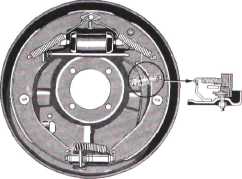|
1949 Delco Brakes Service Manual (Courtesy of Pat Gizz) |
|||
|
DELCO BRAKE SERVICE MANUAL |
|||
|
|
|||
|
commonly known as a
self-energizing type which means that the secondary shoe pressure exerted
against the drum, due to the action
of the wheel
cylinder, is increased
substantially as the result of wrapping action of the primary shoe during
forward movement of the car. The effect is that lighter brake pedal pressures are required on the
part of the operator.
Hydraulic pressure, developed in
the master cylinder as the result of brake pedal movement, is in turn
distributed to the four brake assemblies by means of pipe lines. This
pressure is then converted into mechanical movement by the wheel cylinders
which expand the brake shoes and linings and bring them in contact with the drums. The amount
of force exerted by the wheel
cylinder is dependent on (1) the pressure exerted in the master
cylinder, and (2) the wheel cylinder piston size—the larger the piston the
greater the mechanical force. The initial brake pedal movement stops when
shoe clearances ore taken up,
and further pressure on the brake pedal produces correspondingly
higher pressures within the hydraulic system causing greater force to
be exerted by the brake shoes and linings against the drums. The driver's
effort is multiplied on the master
cylinder piston by the leverage of the brake pedal. The mechanical
advantage at the beginning of the pedal stroke is approximately
7-1/2 to 1; near the floor mat, it is approximately 6 to
1. This is a good reason for keeping brakes properly
adjusted.
As the brake pedal is allowed to
return to the released position, the hydraulic pressure is relieved and brake shoe retracting springs draw the
shoes together, pressing the wheel cylinder pistons
and |
cups back toward each other
inside the wheel cylinder, thus causing the brake fluid to flow back
through the pipe lines into the master
cylinder.
SERVICE
INSTRUCTIONS
The mechanic should, first of
all, carefully determine from the car owner all of the peculiar
characteristics of the brakes on his car. By so doing and by using
the Trouble Diagnosis Chart near the end of this manual, it is possible to
correct existing but perhaps not apparent troubles, such as a broken or
weak return spring, improper fluid, air in hydraulic brake system, etc.
Prior to making minor or major brake adjustments, always remove the right
front wheel so that the customer can see the condition of his brakes and
lining. At the same time, point out to the customer any signs of wear on king bolt,
shackles, and steering mechanisms; loose backing plates; unequal tire pressure or other
conditions that might affect
brake operation. |
||
 |
|||
|
Fig. 15—Delco Hydraulic Brake Assembly
(Typical) |
|||
|
|
|||
|
MINOR BRAKE
ADJUSTMENT |
|||
|
|
|||
|
(Covers adjustment for lining
wear when readjustment of anchor pin is not necessary.) Note:
General condition of linings on all four wheels can usually be determined by removing right
front wheel and inspecting linings.
To
determine whether anchor pin is in correct position, proceed as
follows: |
Insert a feeler gauge through the
inspection hole in the drum between the secondary lining and the drum
about 1-1/2" from the anchor pin end of the lining. (See Special
Instructions for Buick under "Major Brake Adjustment.") Should the
clearance be greater than .012" or less than .005", the anchor pin must be
readjusted. (See "Major Brake Adjustment" for
procedure.) |
||
|
|
|||
|
12 |
|||
|
|
|||